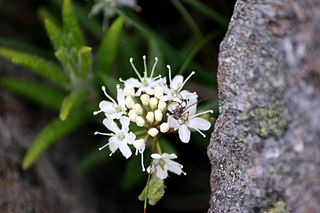
Labrador tea is a common name for three closely related plant species in the genus Rhododendron as well as an herbal tea made from their leaves.

Ledum was a genus in the family Ericaceae, including 8 species of evergreen shrubs native to cool temperate and subarctic regions of the Northern Hemisphere and commonly known as Labrador tea. It is now recognised as a subsection of section Rhododendron, subgenus Rhododendron, of the genus Rhododendron.
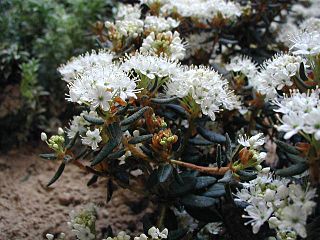
Rhododendron tomentosum, commonly known as marsh Labrador tea, northern Labrador tea or wild rosemary, is a flowering plant in the subsection Ledum of the large genus Rhododendron in the family Ericaceae.

Chrysomyxa ledi var. rhododendri is a plant pathogen responsible for the disease spruce needle rust.
The biogeoclimatic zones of British Columbia are a classification system used by the British Columbia Ministry of Forests for the Canadian province's fourteen different ecosystems. The classification system exists independently of other ecoregion systems, one created by the World Wildlife Fund and the other in use by Environment Canada, which is based on one created by the Commission for Environmental Cooperation (CEC) and also in use by the American Environmental Protection Agency (EPA). The system of biogeoclimatic zones was partly created for the purpose of managing forestry resources, but is also in use by the British Columbia Ministry of Environment and other provincial agencies. A biogeoclimatic zone is defined as "a geographic area having similar patterns of energy flow, vegetation and soils as a result of a broadly homogenous macroclimate."

Choate Island, also known as Hog Island, is an island located in the Essex River Estuary in Essex, Massachusetts. It is part of the Crane Wildlife Refuge, which is owned and managed by The Trustees of Reservations. The 135-acre (0.55 km2) island is a refuge for a variety of birds and animals. It is surrounded by a salt marsh and has a spruce forest which was planted in the 1930s and makes the island easily visible from much of the surrounding area. The island has been inhabited by the Native Americans of the area, and was visited by early Europeans, who established farming on the island. The Choate House, built around 1730, remains relatively unchanged.

Chrysomyxa is a genus of rust fungi in the family Coleosporiaceae. The genus, widespread in the Northern Hemisphere, contains about 23 species. Rust fungi in the genus Chrysomyxa occur in boreal forests of the northern hemisphere on Pinaceae,, and most species alternate to angiosperm hosts in the Ericaceae.
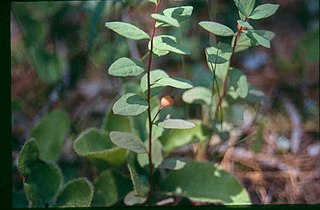
Geocaulon is a monotypic genus of flowering plants in the family Santalaceae containing the single species Geocaulon lividum, which is known by the common names northern comandra and false toadflax. It is native to northern North America, where it is common and widespread from Alaska to Newfoundland and into the northernmost contiguous United States.
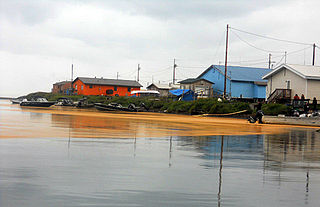
Chrysomyxa ledicola is a plant pathogen responsible for the disease large-spored spruce-Labrador tea rust. It affects white spruce, black spruce, Sitka spruce, Englemann spruce, and Labrador-tea. It is also the cause of the orange goo that covered the Iñupiat village of Kivalina, Alaska in the summer of 2011.
Chrysomyxa abietis, or spruce needle rust, is a species of rust fungi in the Coleosporiaceae family that is native to eastern Europe and northern Asia. It was introduced to Australia, New Zealand and the United States.
Chrysomyxa himalensis, is a species of rust fungi in the Coleosporiaceae family that can be found on Rhododendron and Picea species in the Himalayan region of southern Asia and was introduced in the United States.

Rhododendron columbianum, commonly known as western Labrador tea, swamp tea, or muskeg tea, is a shrub that is widespread in the western United States and in western Canada, reported from British Columbia, Alberta, Washington, Oregon, Idaho, California, Montana, Wyoming, Utah, Nevada, and Colorado. It grows in wet places from sea level up to 3,500 m (11,000 ft). It was formerly known as Ledum columbianum. Its origins date back to the late Pliocene.

Ledol is a poisonous sesquiterpene that can cause cramps, paralysis, and delirium. Caucasian peasants used Rhododendron plants for these effects in shamanistic rituals.
Spruce broom rust or yellow witches' broom rust is a fungal plant disease caused by the basidiomycete fungus known as Chrysomyxa arctostaphyli. It occurs exclusively in North America, with the most concentrated outbreaks occurring in northern Arizona and southern Colorado on blue and Engelmann spruce, as well as in Alaska on black and white spruce. This disease alternates its life cycle between two hosts, with the spruce serving as the primary host and bearberry serving as the secondary or alternate host. The name for the disease comes from the distinctive “witches broom”, commonly yellow in color, which forms on the spruce after young needles have been infected. Management must be carried out through physical or mechanical methods, such as the pruning of brooms or the removal of the secondary host from the area, because no chemical control measures have yet been determined to be economically effective. Generally, spruce broom rust is seen as a mostly cosmetic issue, and it is very rarely the direct cause of tree death; however, research has shown a reduction in overall productivity and health of infected trees, making it an important issue for logging and timber companies.
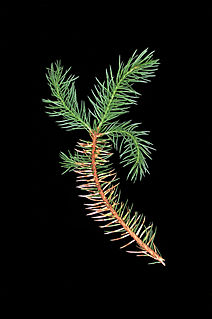
Chrysomyxa weirii, is a fungus that causes a disease, commonly known as Weir's cushion rust, of spruce trees. It is mostly a cosmetic problem, causing yellowish spotting and banding on spruce needles, but in some cases can cause severe premature defoliation. Weir’s cushion rust can also disfigure and reduce growth of spruce trees by targeting the tender needles of newly emerging shoots. This pathogen's spores are spread by wind and water splash and germinate to infect newly developing needles on the same spruce, or neighboring spruce trees. Unlike many other rust disease pathogens, C. weirii is autoecious, only infecting spruce trees. C. weirii is also microcyclic, producing only two of the five possible spore stages common in rust fungi. Trees affected by Weir's cushion rust usually have obvious symptoms, but if treated correctly, the disease can be managed.
Chrysomyxa cassandrae is a fungus that occurs throughout the North Temperate Zone wherever Chamaedaphne calyculata occurs, independent of host alternation. Aecial hosts include white spruce.

Chrysomyxa ledi is a fungus. It occurs in Eurasia throughout the range of its broad-leaved hosts. The aecial stage is found on native and exotic spruces in Europe, including white and Engelmann spruces.
Chrysomyxa nagodhii is a species of rust fungus in the family Coleosporiaceae. It was described as new to science by Canadian mycologist Patricia E. Crane in 2001. It probably occurs throughout the range of Ledum decumbens and Rhododendron groenlandicum. On Picea, spermogonia and aecia occur on distinct rusty yellow bands on current-year needles.
Chrysomyxa neoglandulosi probably occurs wherever its telial host Ledum glandulosum Nutt. is found. The only reported aecial host, Engelmann spruce, occurs in montane to subalpine areas in western Canada and the United States.
The spruce cone rust, caused by the rust fungus Chrysomyxa pirolata Wint., affects spruces in 3 continents, including white spruce in Canada. Alternate hosts of the fungus are several species among 3 genera of wintergreen: Pyrola spp., Orthilia spp., and Moneses spp.. Diseased cones open prematurely and orange-yellow aeciospores are sometimes produced in such quantity as to color the forest floor and lake surfaces. Up to half of a cone crop can be affected, and most of the affected cones do not produce viable seed. Some localities commonly experience damage to 20% to 30% of cone crops, a factor to be considered in the siting of seed orchards.









